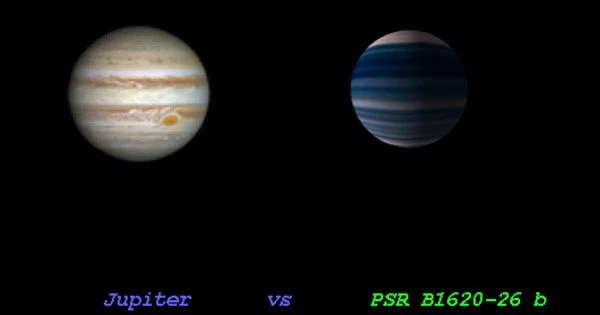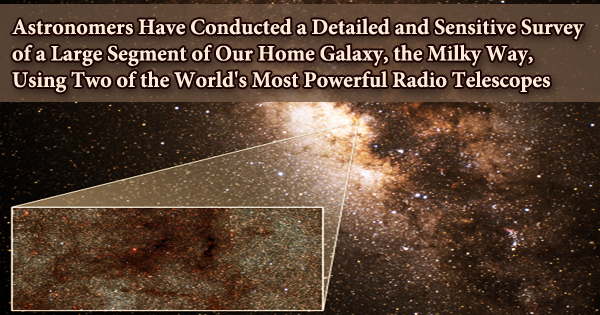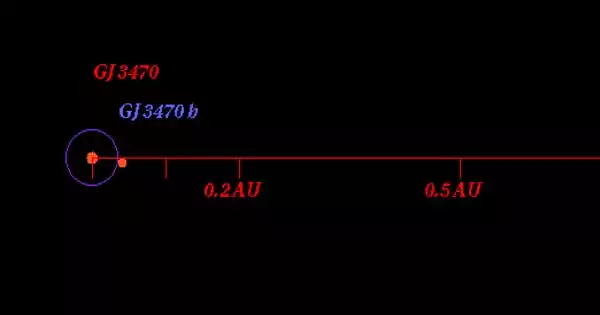PSR B1620-26 b is an exoplanet that orbits a star of unknown type. It is an exoplanet about 12,400 light-years from Earth in the constellation Scorpius. It has a mass of 2.5 Jupiters, takes 95 years to complete one orbit around its star, and is 23 AU away from it. Due to its extreme age, it has earned the unofficial nicknames “Methuselah” and “the Genesis planet” (named after the Biblical character who, according to the Bible, lived to be the oldest person).
Its discovery was made public in 2003. The planet is the first to be confirmed to be in a circumbinary orbit around the two stars of PSR B1620-26 (a pulsar (PSR B1620-26 A) and a white dwarf (WD B1620-26). It is also the first planet found in a globular cluster. The planet is one of the oldest known extrasolar planets, believed to be about 12.7 billion years old.
Mass, orbit, and age
PSR B1620-26 b is an exoplanet that orbits the star PSR B1620-26, which is 12393.9 light-years (3800.0 pc) from our Solar System. Its discovery was made public in 2003. PSR B1620-26 has an apparent magnitude of 24.0 and an absolute magnitude of 11.1. The extrasolar planet PSR B1620-26 b orbits the star PSR B1620-26 every 36525.0 days at an orbital distance of 23.00 AU in this planetary system.
PSR B1620-26 b has a mass 2.627 times that of Jupiter and orbits at a distance of 23 AU (3.4 billion km), which is slightly greater than Uranus’s distance from the Sun. The planet’s orbit takes about 100 years.
The triple system is located just outside the core of the Messier 4 globular cluster. The cluster’s age has been estimated to be around 12.7 billion years, and because all stars in a cluster form around the same time, and planets form alongside their host stars, PSR B1620-26 b is also likely to be around 12.7 billion years old. This planet is much older than any other known planet, and it is nearly three times the age of Earth. Throughout its existence, it has gone through several stages.

Host stars
PSR B1620-26 b orbits a pair of stars. The primary star, PSR B1620-26, is a pulsar, a neutron star spinning at 100 revolutions per second, with a mass of 1.34 M☉, a likely radius of around 20 kilometers (0.00003 R☉) and a likely temperature less than or equal to 300,000 K. The second is a white dwarf with a mass of 0.34 M☉, a likely radius of around 0.01 R☉, and a likely temperature less than or equal to 25,200 K. These stars orbit each other at a distance of 1 AU about once every six months. The age of the system is 12.7 to 13 billion years old, making this one of the oldest binary stars known. In comparison, the Sun has an age of 4.6 billion years.
The binary system’s apparent magnitude, or how bright it appears from Earth’s perspective, is 24. It is far too dim to be seen with the naked eye.
Evolutionary history
The origin of this pulsar planet is still unknown, but it did not form where it is now. It is unlikely that a planet could remain in orbit after a star’s core collapses to a neutron star and ejects most of its mass in a supernova explosion due to the decreased gravitational force. It is more likely that the planet formed in orbit around the star that has now evolved into a white dwarf, and that the star and planet were captured into orbit around the neutron star only later.
Stellar encounters are uncommon in the Milky Way’s disk, where the Sun is located, but they are common in the dense cores of globular clusters. At some point during the 10 billion years, the neutron star is thought to have encountered and captured the host star of the planet into a tight orbit, probably losing a previous companion star in the process. About half a billion years ago, the newly captured star began to expand into a red giant.
Discovery
PSR B1620-26 b, like nearly all extrasolar planets discovered prior to 2008, was discovered through the Doppler shifts its orbit induces on radiation from the star it orbits (in this case, changes in the apparent pulsation period of the pulsar). In the early 1990s, a group of astronomers led by Donald Backer determined that a third object was required to explain the observed Doppler shifts while studying what they thought was a binary pulsar.
Within a few years, the planet’s gravitational effects on the orbits of the pulsar and white dwarf were measured, yielding an estimate of the mass of the third object, which was too small to be a star. The conclusion that the third object was a planet was announced by Stephen Thorsett and his collaborators in 1993.
















